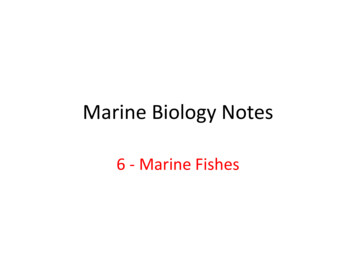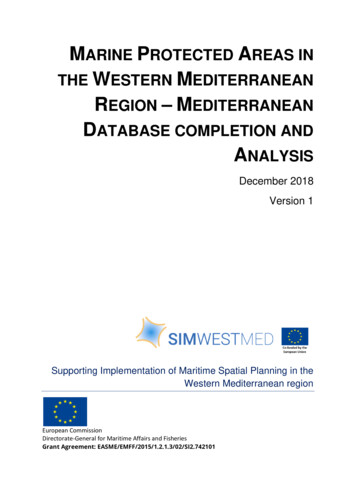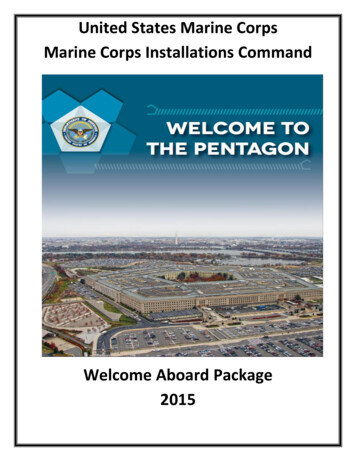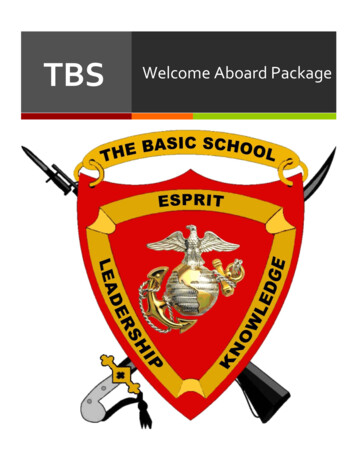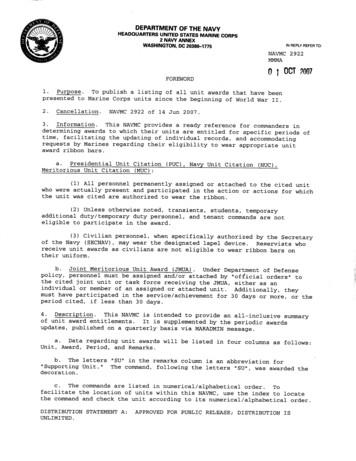
Transcription
UNITED STATES MARINE CORPSMARTIAL ARTS CENTER OF EXCELLENCETHE BASIC SCHOOL24191 GILBERT ROADQUANTICO, VIRGINIA 22134Martial Arts Instructor CourseStudent OutlineRevised s/tbsmace
TABLE OF CONTENTSLesson IDLesson TitlePage #MAIB1000Anatomy and Physiology3MAIB1005Prepare for Instruction13MAIB1010Deliver a MCMAP Period of Instruction23MAIB1015Maintain MCMAP Record41MAIB1020Free Sparring49MAIB1025Conduct Risk Management59MAIB1030The Components of Wellness69MAIB1035LPEmploy the Continuum of Force83MAIB1040LPHistory and Structure of MCMAP89MAIB1045Administer Belt Ranking Achievement Test95MAIB1050LPMCMAP Methodology101MAIB1055Human Dimensions of Combat107MAIB1060MCMAP Combat Conditioning1171
2
MAIB1000UNITED STATES MARINE CORPSMARTIAL ARTS CENTER OF EXCELLENCETHE BASIC SCHOOL24191 GILBERT ROADQUANTICO, VIRGINIA 22134STUDENT OUTLINEANATOMY AND PHYSIOLOGYMAIB1000MARTIAL ARTS INSTRUCTOR COURSEM02MMETAPPROVED BY: LtCol (Ret) Shusko, J. C. DATE: 1 June 20153
MAIB1000LEARNING OBJECTIVESa. ENABLING LEARNING OBJECTIVES(1) Given exam materials, identify vulnerable points ona human body in accordance with MCRP 3-02B. (MCCS-GREN-1028a)(2) Given exam materials, identify a human body’sprimary weapons in accordance with MCRP3-02B. (MCCS-GREN-1028b)1. TARGET AREAS OF THE BODY. There are five major target areasof the body: Head, Neck, Torso, Groin, and Extremities.a.The Head(1) Cranium. The cranium or skull houses and protectsthe brain. The cranium is made up of eight dense bones, whichare fused together, therefore, is not a good target. However, apowerful blow delivered with a weapon such as a club, can causea concussion, unconsciousness, or death.(2) Ears(a) Anatomy. The ear consists of three major parts:the external ear, the middle ear, and the internal ear. Theexternal auditory canal allows external sound vibrations to passinto the skull. The opening to this canal is called theexternal auditory meatus. The eardrum lies at the innermostpart of the external ear, next to the middle ear. Sound wavestransform into mechanical impulses within the middle ear andinternal ear. The internal ear controls equilibrium and balance.(b) Results of an Attack. When the ears are struck,immobilizing effects can occur due to air being trapped andforced down the external auditory canal and into the eardrum.The eardrum can burst causing extreme pain, loss of hearing, orbleeding from the mouth or ear. In addition, balance can bedisrupted and a loss of equilibrium could occur. A cupped handstrike is particularly effective on the ears.(3) Nose(a) Anatomy. The nose is comprised of cartilage andtwo nasal bones fused at the mid-line to form the bridge of thenose.(b) Results of an Attack. Strikes to this regioncan cause watering of the eyes and nose bleeding. The bone and4
MAIB1000cartilage can easily break if struck at a 45-degree angle orstraight on with dominant force.(4) Mandible(a) Anatomy. The mandible (jaw) is attached to theskull by a hinged joint called the temporomandibular joint(TMJ).(b) Results of an Attack. The mandible can bedislocated when struck downward or upward at a 45-degree angle.The preferred target area is the tip of the mandible (chin).Hitting the jaw can cause unconsciousness because the vagusnerve running up against the socket behind the jaw controls somemotor function and neurological functions of the body includingregulating breathing and heart rate. Striking the side of themandible near the TMJ may break the joint.b.The Neck(1) Sides of the Neck(a) Anatomy. The sides of the neck contain thesternocleidomastoid muscles and numerous arteries and veins. TheSternocleidomastoid muscle is responsible for supporting andflexing the head. Beneath this muscle lies the carotid arteryand jugular vein. The carotid artery feeds oxygen-enrichedblood from the heart to the brain; the jugular vein returnsoxygen-depleted blood from the brain to the heart. The carotidsinus is located at the juncture of the carotid arteries andregulates blood pressure.thisto afrominto(b) Results of an Attack. Effects of a strike toarea range from dizziness, unconsciousness, and death duecomplete collapse of the bloodlines carrying blood to andthe brain. Striking the carotid sinus can fake the bodyshutting down, and it can stop the heart.(2) Throat(a) Anatomy. The front of the neck or throat regioncontains the esophagus and the trachea. The esophagus is astraight, collapsible tube that allows food to enter thedigestive system. Directly in front of the esophagus is thetrachea, which is the air tube, leading to the lungs. Thelarynx serves as the opening to the trachea. The jugular notchis located at the base of the neck in the notch formed at thecenter of the clavicle.5
MAIB1000(b) Results of an Attack. When the front of theneck is struck, cartilage can puncture the trachea, disruptingbreathing. Pressure applied to the jugular notch with a quickstabbing motion serves as a distraction technique. Strikes tothis area can cause serious damage including shock,unconsciousness, and even death.(3) Back of the Neck(a) Anatomy. The vertebrae house and protect thespinal cord. There are 7 cervical vertebrae immediately behindthe skull that are identified as C1-C7. C1 is the top mostvertebrae which forms the joint connecting the skull and thespine.(b) Results of an Attack. Over-rotating the neckcan misalign the vertebrae and damage the spinal cord. Thiswill disrupt the neurological functions controlled by the spinein this area, including respiratory functions. Strikes to theback of the neck (cervical vertebrae) where the base of theskull meets the spine can have a devastating effect causingparalysis or even death.c.The Torso(1) Spinal Column(a) Anatomy. The spinal column is made of 33vertebrae that are divided into five regions (cervical,thoracic, lumbar, sacral, coccyx). It supports the structure ofthe body and protects the spinal cord, which combines with thebrain to form the central nervous system.(b) Results of an Attack. If the spinal column isdamaged it will result in extreme pain and loss of mobility.This could also sever the spinal cord, resulting in paralysis.Shock, cardiac arrest, unconsciousness, and death could be theresult.(2) Thorax(a) Anatomy. The thorax (ribcage) consists of 12pairs of ribs that house the major internal organs of the torso.They are connected to the thoracic vertebrae and the sternum.The last two pairs are called floating ribs because they are notconnected to the sternum. The xiphoid process is a smallbrittle extension of the lower part of the sternum.6
MAIB1000(b) Results of an Attack. Strike to this area witha can cause intense pain and loss of motor function. Thefloating ribs and xiphoid process are more susceptible to damagebecause they are not supported. Fractured bones may causedamage to internal organs.(3) Internal Organs(a) Anatomy. The major internal organs of the torsoinclude the lungs, heart, liver, spleen and kidneys. The lungsprimary function is to transport oxygen to the bloodstream andexcrete carbon dioxide. The heart is a pear shaped, muscularorgan, responsible for pumping blood through the body byrepeated, rhythmic contractions. The liver plays a major rolein metabolism and has a number of functions in the body,including glycogen storage and drug detoxification. The spleendestroys old red blood cells and holds a reservoir of blood.The kidneys are located just under the bottom ribs on eitherside of the spinal column. They filter waste from the blood andexcrete it as urine.(b) Results of an Attack. Damage to the lungs willdisrupt or stop breathing. Damage to the heart can cause shock,unconsciousness, and death. Strikes to the kidneys, liver andspleen will cause severe pain and disrupt bodily function.d.The Groin(1) Groin(a) Anatomy. The groin is the region where the legsmeet the torso. It includes the lower abdomen and inner thighs.This is a good target area because it contains large arteriesand nerves, making it highly sensitive. The pelvis supports theweight of the entire upper body.(b) Results of an Attack. An attack can be quicklydebilitating, due to the large number of sensitive nerves. Agroin attack is found painful by both genders, and can beincapacitating. A powerful strike can fracture the pubic bone,resulting in immediate loss of mobility.(2) Coccyx(a) Anatomy. The coccyx, commonly referred to asthe tailbone, is the final segment of the human vertebralcolumn. It provides an attachment for muscles, such as the7
MAIB1000gluteus maximus, and serves as a shock absorber when the personsits down.(b) Results of an Attack. Strikes to the tailboneat an upward angle can result in severe pain and paralysis,immediately disabling an opponent.e.The Extremities(1) Joints(a) Anatomy. Two primary types of joints in thebody are hinge joints and ball and socket joints. The elbowsand knees are hinge joints that will only bend in one direction.The shoulders and hips are ball and socket joints that haverange of motion in all directions. The wrists and ankles arecomplex joints with many bones and a wide range of motion.(b) Results of an Attack. Joints can be manipulatedby forcing them in the opposite direction they are designed tobend or by forcing them beyond their natural range of motion.Applying the correct pressure will cause pain complianceallowing the control of the subject. Striking or forcefullybending a joint can damage tissue, causing intense pain and lossof functionality.(2) Muscles(a) Anatomy. The three types of muscles areskeletal, smooth and cardiac. Skeletal muscle or "voluntarymuscle" is anchored by tendons to bone and is used to affectskeletal movement such as locomotion and in maintaining posture.Smooth muscle or "involuntary muscle" is found within the wallsof organs and structures. Unlike skeletal muscle, smooth muscleis not under conscious control. Cardiac muscle is also an"involuntary muscle" but is found only within the heart.separatedpain. Inavailableresult in(b) Results of an Attack. Skeletal muscles can befrom the bone or squeezed with the fingers to causeaddition, muscles can be struck with any weaponto cause massive bruising and tearing which willpain serving to weaken an opponent.(3) Bones(a) Anatomy. The bones in the arms are the humerus(upper arm), radius (thumb side), and ulna (pinky side). Theclavicle (collarbone) acts as a strut for the arm and supports8
MAIB1000movement. The bones of the legs are the femur (thighbone),tibia (shinbone), and fibula. The femur is the longest andstrongest bone in the body.(b) Results of an Attack. A powerful strike with ahard object can bruise or fracture a bone. This will result inextreme pain and loss of functional in the limb. Broken bonesin the lower body will prevent mobility.(4) Nerves(a) Anatomy. The radial and ulnar nerves travelalong the radial and ulna bones, respectively, and makeexcellent striking areas. The femoral nerve (inside of thigh)and peroneal nerve (outside of thigh) are good targetsespecially since targets below the waist are not usually coveredwith body armor.(b) Results of an Attack. A powerful blow to anerve can cause a temporary paralysis of the nerve, causing painand serving to weaken an opponent. Effectiveness will vary dueto individual sensitivity and pain tolerances.2. PRESSURE POINTS OF THE BODY. There are many pressure pointson the body. We will discuss the nose, eyes, mastoid process,and brachial plexus.a.Nose(1) Anatomy. The nose is positioned right acrossseveral nerves of the face and head. The infra-orbital nerve islocated at the base of the nose.(2) Results of an Attack. Pressure applied beneath thenose and above the upper lip at an upward angle can produce paincompliance.b.Eyes(1) Anatomy. The eyes are soft tissue set into socketsin the skull called orbital fissures.(2) Results of an Attack. The eyes are vulnerablebecause they are extremely sensitive to touch and could easilybe gouged. Dirt and debris can be thrown into the eyes of anopponent as a distraction. Attacking the eyes may result inwatering, involuntary closing, pain, and even shock.9
MAIB1000c.Mastoid Process(1) Anatomy. The mastoid process is the point ofattachment for many neck muscles, located behind the ear.(2) Results of an Attack. Pressure applied at an upwardangle to the mastoid process results in pain, which can be usedto gain compliance.d.Brachial Plexus(1) Anatomy. A plexus is a point at which severalnerves combine. The brachial plexus is in the shoulder at itsjuncture to the torso, underneath the collarbone. It can beaccessed underneath the armpit.(2) Results of an Attack. Pressure applied upward intothe armpit can cause pain and can be used to gain compliance.3. WEAPONS OF THE BODY. The arms and legs are the two primaryweapons of the body. They are each broken down into secondaryweapons. Although not generally a weapon, the head can be usedto strike or bit an opponent if necessary.a. The Arms. The arms are the most commonly used weaponsof the body, consisting of the hands and elbows.(1) The Hands. The hands are the instant responseweapons of the body. The primary technique of the hands isstriking but they can also be used for choking, grabbing, andwielding a weapon.(2) The Elbows. The elbow does not have all thefunctions of the hands, but can deliver a higher volume of forceat close range. The bones of the elbows are larger and harderthan those in the hands, making a stronger striking surface.b. The Legs. The legs are considered the most powerfulweapon of the body, consisting of the feet and knees.(1) The Feet. The feet are not easily employed asweapons during an engagement. It takes training, coordination,and skill to use the feet as weapons. The primary techniquesused are kicks and stomps. They produce more force than anyweapons of the arms because the lower body and hips are largerand more powerful. The shins may also be utilized for astriking surface.10
MAIB1000(2) The Knees. The largest amount of power can bedelivered from knee strikes. The striking surfaces of the kneeare larger than the feet, and the weight of the leg along withthe drive of the hips produce the power of the strike. Kneestrikes can be used on various target areas of the body anddropping the knee on an opponent is affective.REFERENCES:Gray’s Anatomy, 13th Edition, Clemente, 1985Marine Corps Martial Arts, MCRP 3-02BPhysiology of Sport and Exercise, 2nd Edition, Wilmore, Jack H.;D.L. Costill, ISBN: 073606226211
MAIB100012
MAIB1005UNITED STATES MARINE CORPSMARTIAL ARTS CENTER OF EXCELLENCETHE BASIC SCHOOL24191 GILBERT ROADQUANTICO, VIRGINIA 22134STUDENT OUTLINEPREPARE FOR INSTRUCTIONMAIB1005MARTIAL ARTS INSTRUCTOR COURSEM02MMETAPPROVED BY: LtCol (Ret) Shusko, J. C. DATE: 1 June 201513
MAIB1005LEARNING OBJECTIVESa. TERMINAL LEARNING OBJECTIVES.(1) Given a Master Lesson File, an instructionalsetting, and references; prepare for instruction in accordancewith the Systems Approach to Training (SAT) Manual chapter 4sections 4100 and 4300. (FSIC-IMPL-2101)b. ENABLING LEARNING OBJECTIVES.(1) Given exam materials, identify elements ofpreparation in accordance with the Systems Approach to Training(SAT) Manual chapter 4 sections 4100 and 4300. (FSIC-IMPL-2101a)(2) Given exam materials, identify types ofinstructional settings in accordance with the Systems Approachto Training (SAT) Manual chapter 4 sections 4100 and 4300.(FSIC-IMPL-2101b)1. REVIEW LESSON MATERIALS. Reviewing lesson material involvesall those activities that instructors must perform beforepreparing and conducting instruction. Instructors must have aclear understanding of all aspects of the lesson. This isaccomplished by reviewing the course/training schedule, theMaster Lesson File (MLF), and tests. By reviewing these items,the instructor can identify any conflicts, questions, orpotential problems before the rehearsals begin. The instructorcan then make required adjustments prior to delivering theinstruction to the students. The instructor must ensure thelesson plan, student materials, and media all contain the sameinformation.a. Review Training Schedule. The instructor should reviewthe schedule as early as possible before instruction begins.This allows the instructor ample time to resolve any conflictsor problems. By reviewing the schedule early, the instructorhas time to schedule resources (ranges, weapons, ortransportation), rehearsals (a dress rehearsal in theinstructional setting), and any administrative requirements(printing of student materials).b. Review Lesson Plan. Detailed lesson plans give theinstructor all of the critical information needed to maximizestudent learning. The purpose of reviewing the lesson plan isto ensure the lesson contains all of the required components; tomatch the learning objectives to the information in the lessonplan; and to personalize the lesson plan to the instructor’s14
MAIB1005style of delivery. After reviewing the lesson plan, theinstructor should fully understand lesson content and haveconfidence in the detailed script that allows for the smooth andeffective delivery of instruction.(1) Lesson Plan Personalization. The instructorpersonalizes the lesson plan, tailoring it to their style ofteaching. Lesson plan personalization allows the instructor tomake the class unique without deviating from the approvedcontent. Personalization includes adding subject matterdetails, related personal experiences, and discussion topicswhich may be needed to cover the topic in greater depth.Personalization also includes the addition of notes to indicatewhen to stress a point, relate a personal experience, or use anexample or analogy.(2) Subject Matter Detail. This type of informationprovides technical data such as purposes, descriptions, facts,operations, and functions. Course references (on the conceptcard) provide this information.(3) Instructional Techniques. Use well-constructedquestions, well-planned media, or additional student/instructoractivities to enhance the lesson.(4) Personal Experience. Relate personal on-the-jobexperiences to the lesson to increase student interest. Relatingpersonal experiences has the positive effect of reinforcing thepractical application of the material. It also serves toincrease student interest and motivation.(5) Examples and Analogies. When possible, support mainpoints of the lesson plan by examples and analogies to simplifythe concepts or ideas being taught. Use them as a part ofpersonalization for each lesson.c. Review Student Materials. An instructor influences thetransfer of learning by the way the content of the Master LessonFile (MLF) is used. Student materials assist the instructor inthe delivery of instruction by providing tools that stimulatethe learner and reinforce key concepts. There are two types ofstudent materials: student outlines and supplemental studentmaterials. All student material must be reviewed to ensure theyare up to date and support the lesson.(1) Student Outlines. The student outline is theprimary document that supports the instruction. This outlineprovides the student with a general structure that highlights15
MAIB1005the main ideas of the class. The primary purpose for reviewingthe student outline is to ensure it is written in proper termsfor the student, not the instructor, and to verify that itcontains all required components.(2) Supplemental Student Materials. Supplementalstudent material is any material, in addition to the studentoutline, provided to the student prior to or during instruction.Supplemental student materials may include handouts, articles,and reference materials. The use and number of supplementalstudent materials is optional, and they can be presented in anyformat that will be easily understood by the student. Theprimary purpose for reviewing supplemental student materials isto ensure the information does not contradict the informationcontained in the student outline.d. Review Media. Instructional media can come in manyforms. The primary purpose for reviewing media is to ensurethat they match the information in the lesson plan and arevisible to the students in the instructional setting.e. Review Operation Risk Assessment Worksheet (ORAW).Instructors must identify the ORAW and review it for safetyissues pertaining to the lesson prior to the conduct of thelesson. The ORAW must also contain the Cease Training Criteria(CTC) for the lesson. These criteria detail the circumstanceswhen training must be stopped. The CTC is specified in thesafety brief of the introduction in the lesson plan. When thereare CTC associated with a practical application or other method,it is reiterated prior to the practical application. Anyproblems concerning the ORAW (such as acquiring resourcesnecessary to implement controls, etc.) must immediately bebrought to the attention of the appropriate authority.f. Review Instructor Preparation Guide (IPG). TheInstructor Preparation Guide is a required element of the MasterLesson File (MLF). This checklist is created to provide theinstructor with information that is critical to the preparationfor implementing the lesson. Detailed information is givenso that the instructor understands what resources are necessaryfor the lesson. Much of the information provided underadministrative information is copied from the concept card.Though this checklist is an MLF item, instructors can make acopy so that they can check off items when preparing for thelesson.g. Review Student Test. The primary purpose for reviewingthe student test is to ensure the instructor has a complete16
MAIB1005understanding of how the students will be evaluated. Every blockof instruction begins with an introduction. One of the steps inthe introduction is to explain how the students will beevaluated. By reviewing the test, the instructor will alsodetermine if the test items are supported by the content of thelesson plan, instructional materials, and student materials.The instructor must never use this information to teach specifictest items or questions.2. CONDUCT REHEARSALS. Rehearsal is the process in which aninstructor practices delivering their lesson. Rehearsing thelesson will reveal the most effective wording, enhance theinstructor’s knowledge of the subject matter, ensure a smoothflow of the presentation, and increase the chances for success.Rehearsal also provides the instructor a gauge of how theirdelivery fits the allocated time for the lesson.a. Types of Rehearsals. The three types of rehearsals are:individual, small critical audience, and dress rehearsal. Eachof these can stand alone; however, preparation is maximized whenthey are all conducted in sequence. It is recommended tovideotape individual rehearsals when possible.(1) Individual. The individual rehearsal requires theinstructor to practice delivering the material alone. Individualrehearsals can take place anywhere, anytime, and at theconvenience of the instructor.(2) Small Critical Audience. After gaining confidencethrough individual rehearsal, the lesson should be presented toa small group of people. Ensure the people selected willprovide constructive feedback. Because of their knowledge onthe subject, other instructors make the best critical audience.Family and friends are not ideal for a critical audience, butthey do provide an opportunity to rehearse in front of people.The instructor should be thick-skinned enough to accept feedbackat face value.(3) Dress. The dress rehearsal should be the finalrehearsal and most important of all rehearsals. By this point,every effort should have been made to remove any discrepanciesin the lesson. This rehearsal should be accomplished in theinstructional setting that will be used when the actual lessonis conducted. Rehearse with all media and equipment that willbe used on presentation day. Also, make certain any assistantinstructors or support personnel are available to rehearseduring the dress rehearsal.17
MAIB1005b. How to Rehearse.when rehearsing.There are several keys to remember(1) Avoid Memorization. Never memorize the lessonbecause it will give the presentation a canned effect thatcauses the instructor to appear robotic. Know the outline(conceptual framework), sequence, and the points to be covered,but do not memorize the lesson verbatim (word for word) from thelesson plan. Below are some recommendations that can help avoidmemorization:(a) Read the lesson plan at least twice andhighlight words or key phrases that need to be emphasized. Ifanything is unclear, request guidance from other instructors.(b) Research the technical manuals and references tobroaden knowledge of the subject.(c) Review all supplemental material.(d) Print the media (3 slides per page) and writenotes on the right hand side of the page. The notes can includekey phrases from the lesson, examples, analogies, stories, oranything else that needs to be mentioned or accomplished whenthat particular slide is displayed.(2) Rehearse by Parts. If there is any part of thelesson that feels uncomfortable or needs more practice, rehearsethat part separately until you gain confidence with the materialand delivery.(3) Rehearse for Criticism. After completing theprevious step, rehearse the lesson for the sake of criticism infront of a small critical audience. This audience should befellow instructors or curriculum developers responsible for thedevelopment of the curriculum.(4) Rehearse the Whole Lesson. After the instructorrehearses and is comfortable with the different parts, thelesson should be rehearsed from start to finish. An instructorcan get a false sense of security when comfortable rehearsingonly specific parts. This is essential to ensure that thelesson flows smoothly.c. Evidence of Rehearsal. The following are indicators ofeffective rehearsal. It is important to note that a lack ofrehearsal may cause students to form negative opinions regardingthe lesson, the instructor's professionalism and abilities, and18
MAIB1005the course or instructional program. However, proper rehearsalwill produce the following positive results.(1) Presentation Flows Smoothly. If the entirepresentation flows smoothly, it is most likely due to instructorrehearsal. Conversely, if the presentation is choppy ordisjointed, it can be presumed that the instructor did notrehearse appropriately.(2) Instructor Appears Knowledgeable. When aninstructor appears knowledgeable about the subject matter, it isevidence of rehearsal. This provides the instructor with thecredibility necessary to gain the respect of the students.(3) Instructor Appears Comfortable. The nextconsideration is whether or not the instructor appearscomfortable in the classroom. The instructor should know whereall the equipment and media are located and the presentationshould not be interrupted because the instructor could notoperate the equipment or media. If the instructor appearsrelaxed while delivering the presentation, then he or she mostlikely spent enough time rehearsing.(4) Time Limit. Further evidence of rehearsal is theeffective delivery of the instruction within the time allocated.If the instructor remains within the time limit, then it is mostlikely due to rehearsal.3. PREPARE THE INSTRUCTIONAL ENVIRONMENT.Prior to delivering instruction, the instructor must prepare theinstructional environment for an organized and smoothpresentation to maximize the transfer of knowledge and skills.The instructional environment refers to the instructionalsetting (classroom), media/equipment, support personnel, studentmaterials, and the administrative functions the instructor mustperform.a. Prepare Instructional Setting (Classroom). Theinstructor must ensure that the instructional setting replicatesthe job setting as much as possible. This is achieved byorganizing and placing required equipment or supplies, as theywould be in the job setting. The instructor must also ensurethat the instructional setting is conducive to learning. This isaccomplished by ensuring the following:(1) Lighting and ventilation are adequate, mediaequipment is accessible, and the climate control is functioningproperly.19
MAIB1005(2) Chairs and desks are available for each student.(3) Unnecessary distractions are removed.(4) If an outdoor area is to be used, themust survey the area to ensure it can be preparedspecific lesson plan and local Standing Operating(SOP). An alternate site should be designated inprimary site cannot be used.instructorper theProcedurethe event the(5) Ensure that all ORM and safety considerations havebeen addressed.b. Prepare Media/Equipment. Prior to the class theinstructor must gather and set up all the instructionalequipment and media required for the presentation of the lesson.Equipment can include items such as DVD players, projectors,computers, etc. Media can include board media (chalkboards, dryerase boards), established media (actual item, printedmaterials), computer media (Computer-Based Tutorials,Interactive Media Instruction), and multimedia (computer aidedgraphics, audio, video). Equipment and media preparation shouldinclude a review of the following requirements:(1) All the required equipment is operational. If theequipment cannot be repaired or replaced, alternate media mustbe obtained.(2) The media must be easily seen and heard from anypart of the instructional area.(3) The equipment is in good condition. The media isappropriate to the subject matter and target audience.c. Brief Support Personnel. Support personnel includeassistant instructors, demonstrators, role players, Corpsmen(when applicable), and any other personnel who will be involvedin the presentation or support of instruction. The instructormust brief support personnel so that each person’s role isclearly understood.(1) The primary instructor is responsible for ensuringthat all personnel are informed when to meet. Some personnelmay need to be at the instructional area early to secure and setup equipment or to have student materials in place prior to thestart o
maib1000 3 united states marine corps martial arts center of excellence the



